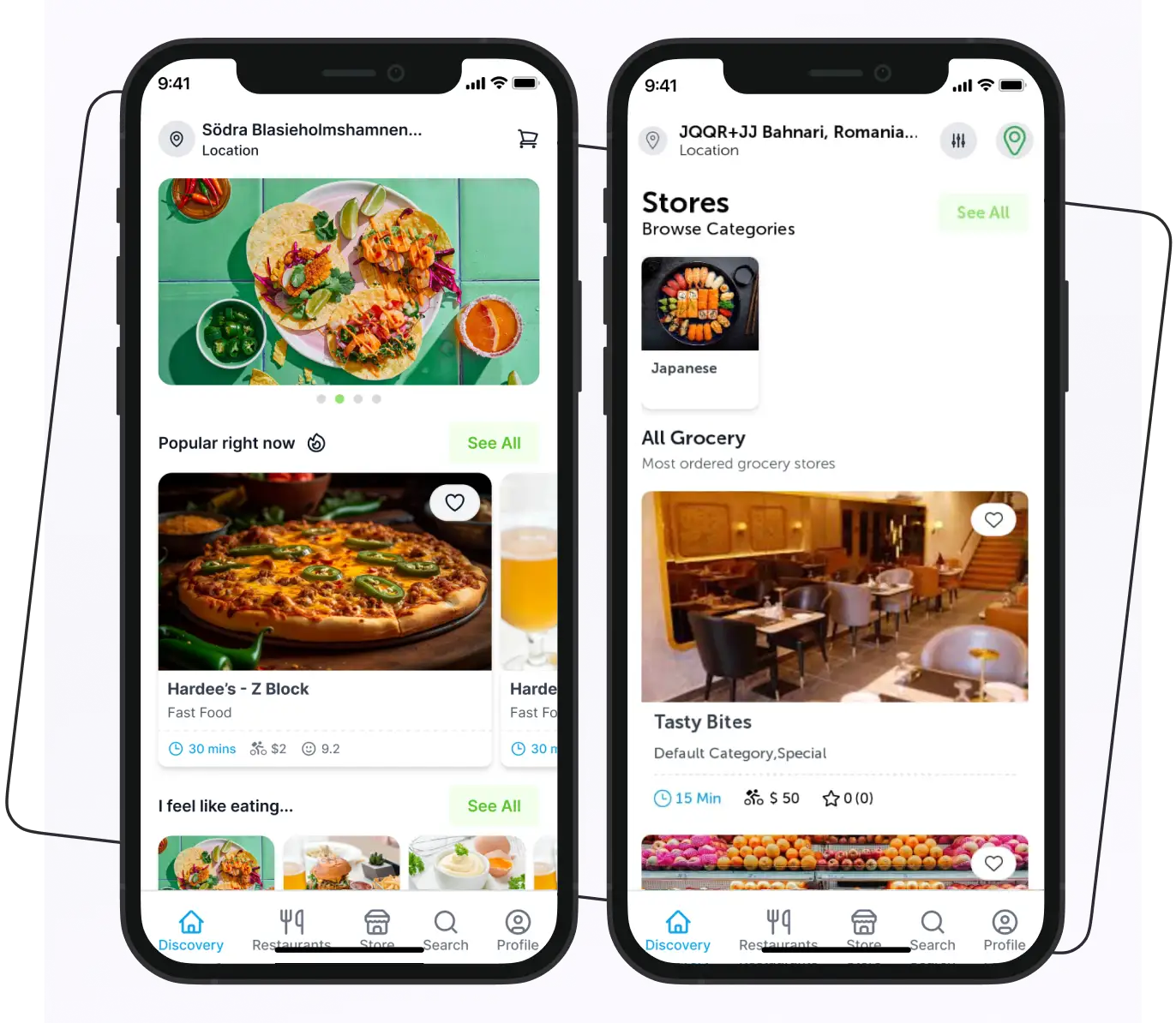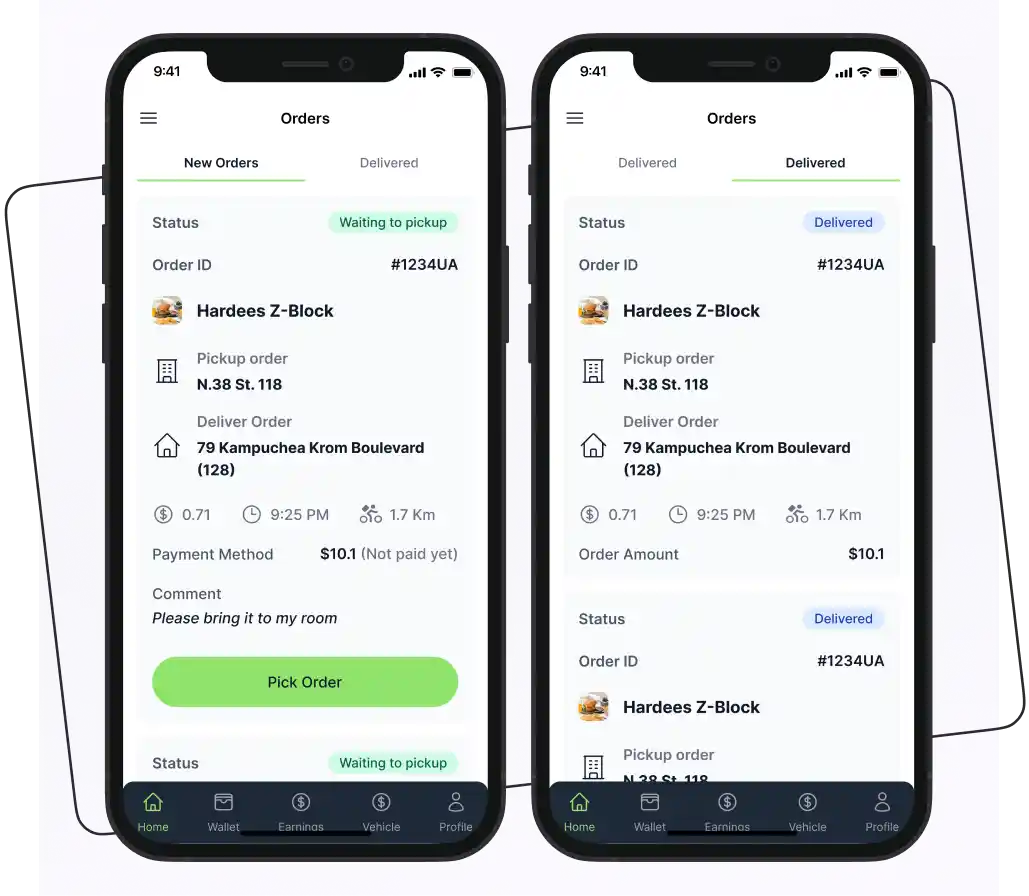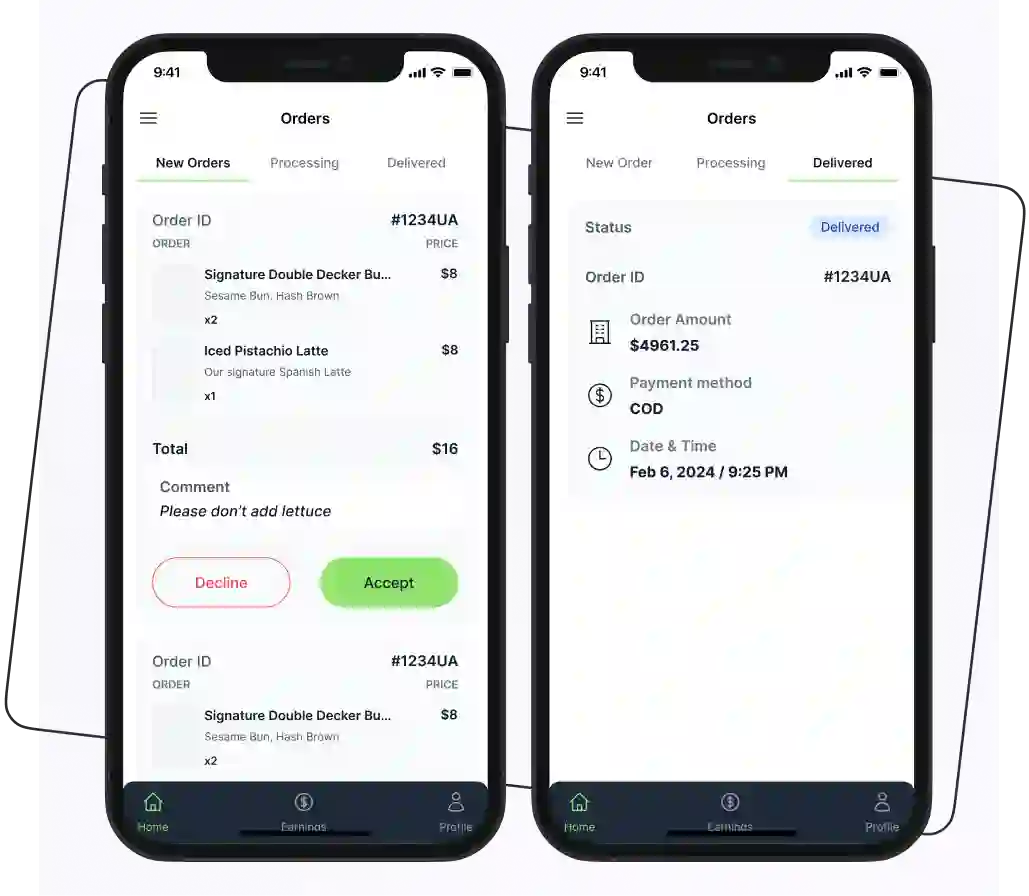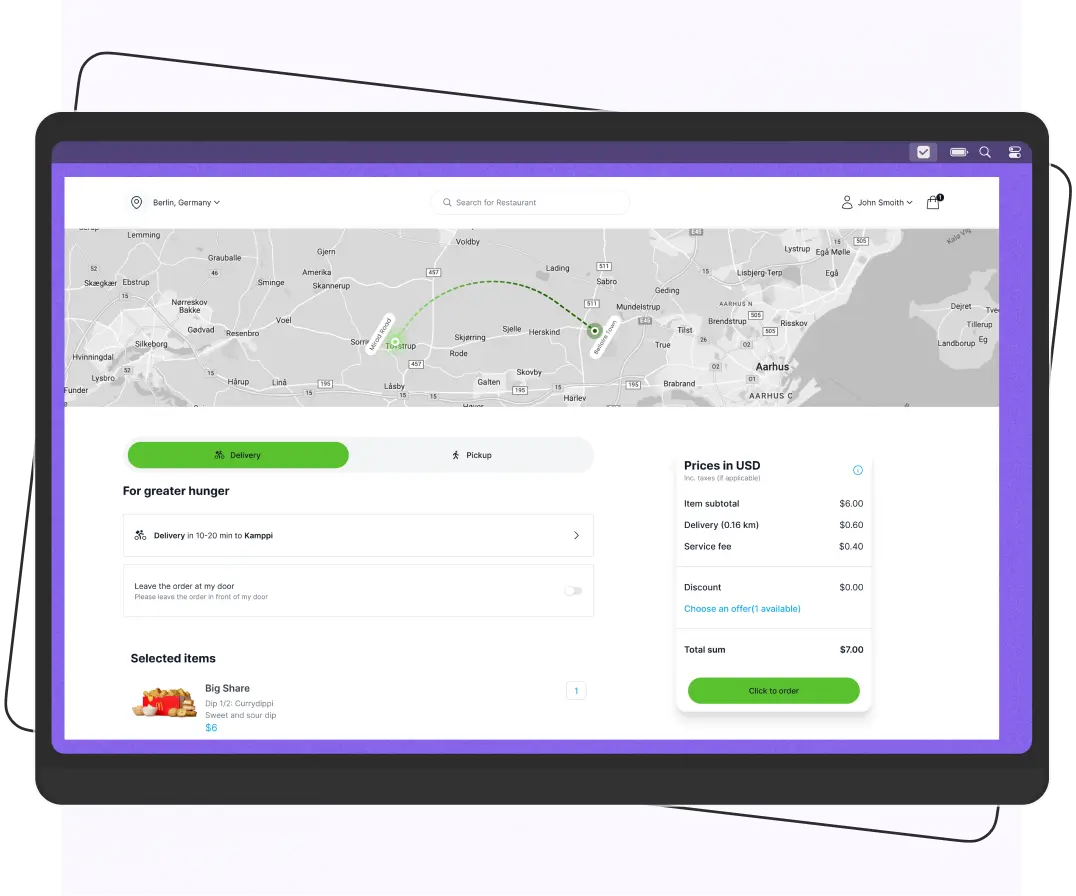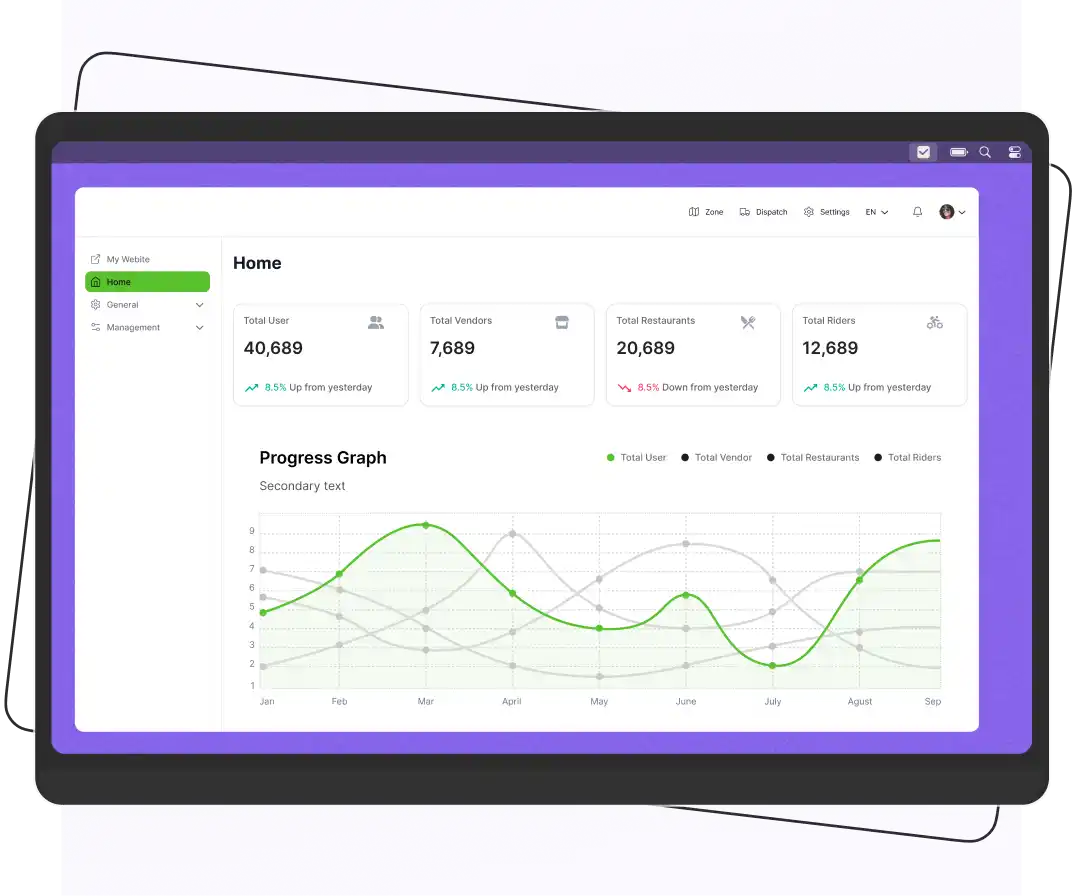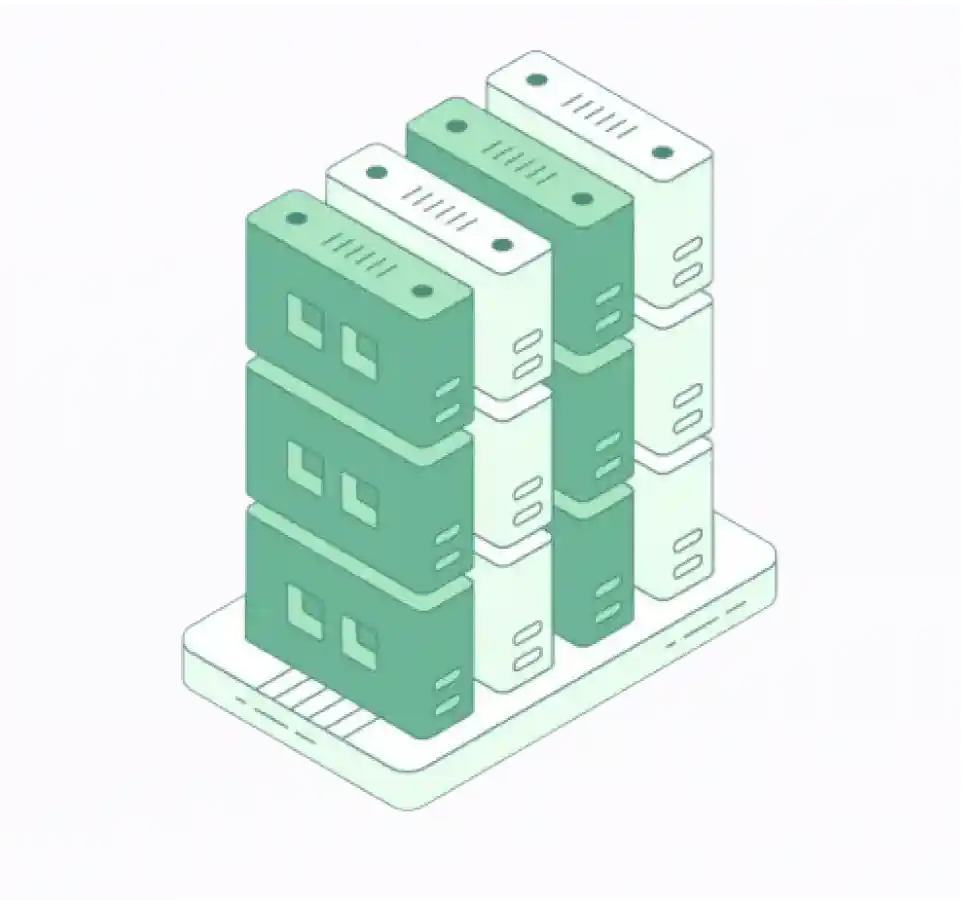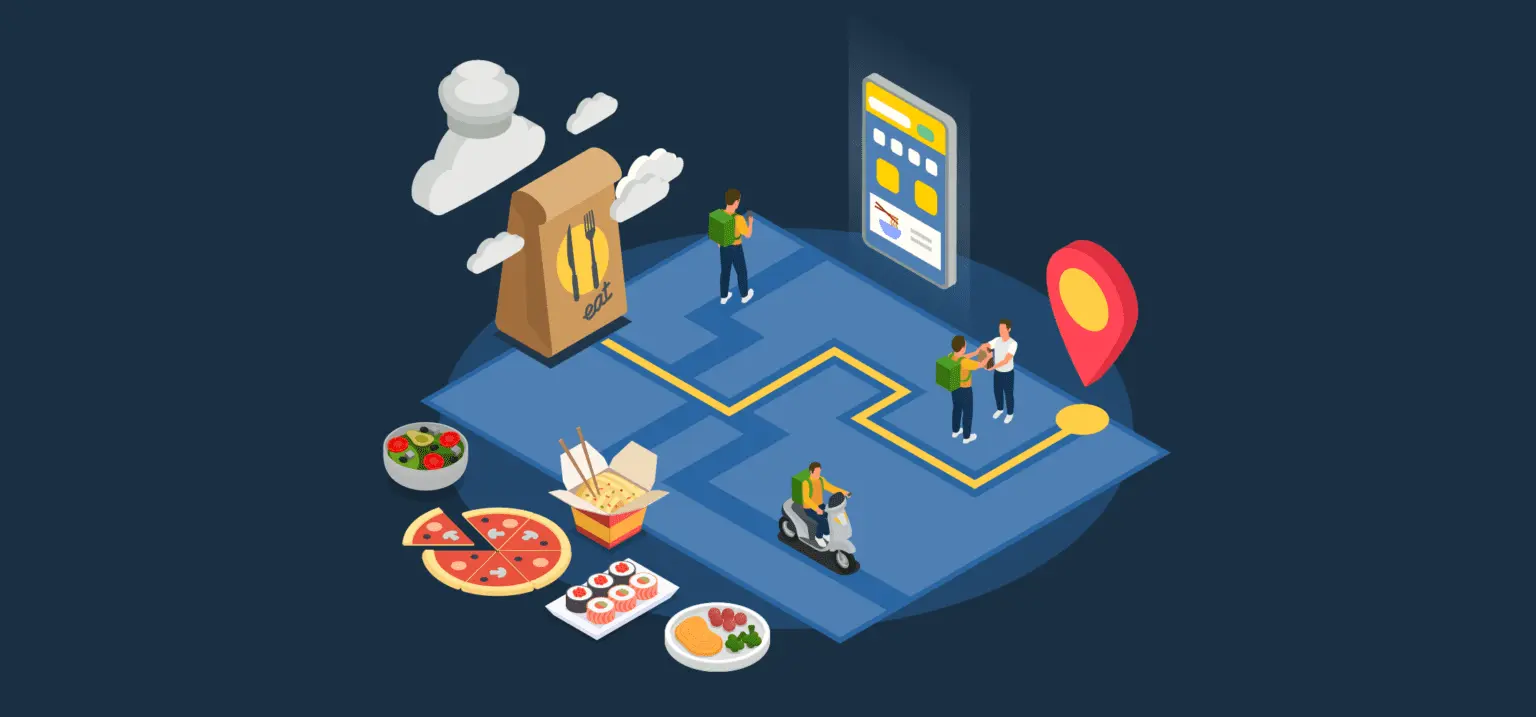
Key Takeaways
- The online food delivery market is projected to reach $1.20 trillion by 2024, indicating significant growth opportunities.
- Key steps to create a successful food delivery app
- Benefits of creating the food delivery app for your restaurant
- Revenue streams for food delivery apps include Commission-based, Subscription-based, and more
- Important app features include user registration, a digital menu, payment options, and ratings.
- Cost of building the food delivery app
- Challenges faced in building the food delivery app
In a world where convenience is important, the demand for food delivery apps is increasing. By 2024, the online food delivery market is projected to reach $1.20 trillion, with over 60% of consumers ordering food online weekly.
To carve out your niche in this competitive market, it’s essential to create a food delivery app that not only meets customer expectations but exceeds them.
This blog will walk you through eight essential steps to developing a standout food delivery app—from conducting thorough market research and defining your unique selling proposition (USP) to selecting the right technology stack and implementing innovative features.
Get ready to turn your vision into reality and capture a slice of this booming industry!
How Does The Food Delivery System Work?
Here is the workflow of the food delivery system.
- Customers sign up on the food app. After signing up, the customers use the app, search restaurants, browse menus, and more.
- The customers add items to the cart that they need to order.
- Before the payment, they also apply codes and discount offers.
- The customer selects the payment option that they find the most suitable.
- The restaurant receives the order notification. Once the restaurant receives the order, the customer gets a notification about the order acceptance.
- When the food is ready, the restaurant owner contacts the nearest rider and assigns an order to them.
- The rider picks up the order from the restaurant and the customer receives the notification that their food is on the way.
- After the food is delivered, the customer can share feedback on the food quality, taste, and delivery experience.
How to Create Your Own Food Delivery App?
How to create an app for food delivery?
The food delivery business is an up-and-coming area. However, to create a food ordering app, you should follow the proper steps to help you create a great app.
Below are some steps to help you in this phase, “how to build a food delivery app” that boosts sales and increases revenue.
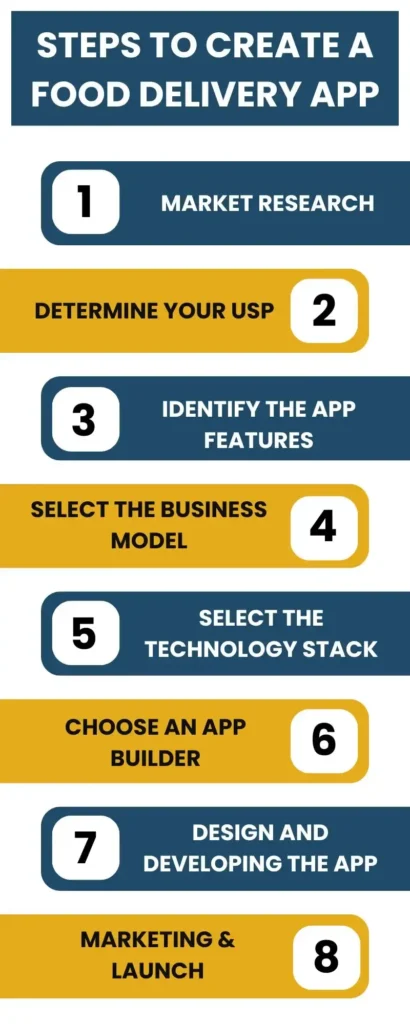
1. Market Research
Before starting the how to make your own food delivery app phase, it is important to research and analyze the market. In this step, you have to consider these things:
- Identify the target audience
- Understand the latest market trends
- Look at the competitor’s strengths and weaknesses
- Customer preferences
With the help of these things, you can make an informed decision and create a food app easily. You can use different research methods that make your data-gathering phase easy. It includes:
- Interviews
- Surveys and questionnaires
- Online databases
- Observations
- Journals
If you don’t have time to do market research, you can consult the professionals to assist you.
2. Determine your USP (Unique Selling Proposition)
Several food delivery apps in the USA are available; you need a captivating USP. With a compelling USP, you can set yourself apart from your competitors and use it as the base of your marketing strategy. The USP can be anything like:
- Providing faster delivery
- Offering unique cuisines
- Providing deals and discounts
- Deliver top-notch food from the best restaurants
For example, Foodpanda’s success stems from its unique combination of real-time tracking, personalized recommendations, and an extensive restaurant network. By offering features like predictive delivery times and tailored suggestions based on previous orders, Foodpanda has carved out a niche in the competitive landscape.
Another example is UberEats, which uses Uber’s vast logistics network to provide rapid delivery times and reliable service, setting it apart from competitors.
3. Identify the App Features
You must identify the unique app features that are easy to build and engaging for the users. Choose features that cater to your target audience and are not available in competitor apps.
Unique Features
You can also add these unique features when you build your own delivery app if you have great programming skills.
- Virtual food tasting
- Table reservation
- Multi-language support
- Virtual tour of the restaurant
- Integrated payment splitting
4. Select the Business Model
Defining the business model is necessary when creating an UberEats alternative, Grubhub clone app, or Postmates clone. Choose the business model that best aligns with your requirements. Below are the business model options that you should consider when creating a food app.
Delivery Services: Your app and business handle all restaurant-to-customer deliveries. These approaches charge restaurants for platform use and a percentage of orders. This model makes more money by charging a percentage on every order or through delivery fees.
Deliveries Handled by Third-Party: All the deliveries are handled by a third party between the restaurants and customers. You’re running an app as a service, but don’t touch the food. This model also makes more money.
Own Food Delivery App: This model works simply and charges the customers for order delivery. The restaurant has its own custom food ordering app and handles all the orders internally.
5. Select the Technology Stack
The technology stack you select to develop a food app depends on the functionality of your app. No matter your plan, it only turns fruitful once you use the right technology stack. Defining the technology stack at the beginning stage helps business owners to achieve their objectives.
The below table outlines some common technology stack options for food apps, based on the key functionality.
| Functionality | Technology Options |
| Backend | |
| Web Application | Node.js, Ruby on Rails, Python (Django, Flask), PHP (Laravel) |
| Microservices | Node.js, Go, Python, Java |
| Database | |
| Relational | MySQL, PostgreSQL, Microsoft SQL Server |
| NoSQL | MongoDB, Cassandra, CouchDB |
| Front-end | |
| Web App | React, Angular, Vue.js |
| Mobile App | iOS (Swift, Objective-C), Android (Java, Kotlin), React Native, Flutter |
| Infrastructure | |
| Cloud Hosting | AWS, Google Cloud, Microsoft Azure |
| Integration | |
| Payment Gateways | Stripe, PayPal, Braintree |
| Additional Features | |
| Real-time Updates | WebSockets (Socket.IO, SockJS) |
| Push Notifications | Firebase Cloud Messaging, Amazon SNS |
| Recommendation Engine | Machine Learning Frameworks (TensorFlow, PyTorch) |
| Analytics | Google Analytics, Mixpanel, Segment |
| Security | |
| Authentication | OAuth 2.0, JWT |
| Data Encryption | SSL/TLS, AES, RSA |
| PCI Compliance | Tokenization, Secure Payment Gateways |
6. Choose an App Builder
You can create an app without having to write code. Easily use the no-code platform to create an app from scratch. You only need to tell the software what to do and how you want your app to look like, everything is handled for you on the backend.
Using the no-code app builder, you can customize everything including menus, button text, color, and screens.
The main benefit of using the no-code platform for your app is that you don’t need to require technical knowledge and at an affordable price you can launch your app in the market.
7. Design and Developing the App
This step requires your time and effort. Better hire a development team or use app customized food delivery app development platforms for creating the app. Below are some stages that help you create your own delivery app.
Prototyping: Use the food ordering app builder and create the user flow logic and the application screens according to your requirements.
UI/UX Design: Design the app interface that is easy to use and incorporates all the functionality.
Development: In on demand food delivery app development phase, developers assemble everything and build the final product.
Testing: When designing the app is completed, start the testing phase. Check all the app functionality and make sure that it is error-free and works well.
8. Marketing and Launch
After creating a food app, start launching your own delivery app. Invest in your food delivery app marketing plan and upload it on the Apple Store and Google Play Store.
Additionally, you can use these best ways help to let your audience know you have an open source food delivery app and boost your app’s download rate and user engagement:
- Provide incentives to the first 100 app download users.
- Use social media channels and promote your app so people know about it.
- Print flyers and put them in your restaurant.
- Place QR codes in your physical location. It encourages in-house clients to download the app instantly.
- Send emails to your subscribers about the app. You can put a discount on the first order on the app.
- Create engaging landing pages on your website so visitors know more about your app.
Why Does Your Restaurant Need to Create Your Own Food Delivery App?
The need for food apps is increasing, and a convenient way for restaurants to connect with customers. Entrepreneurs must invest in a food delivery app to survive in the market. Creating your own food ordering app provides several benefits to the food delivery business.
Below are the reasons that show why food businesses should consider creating a food delivery app.
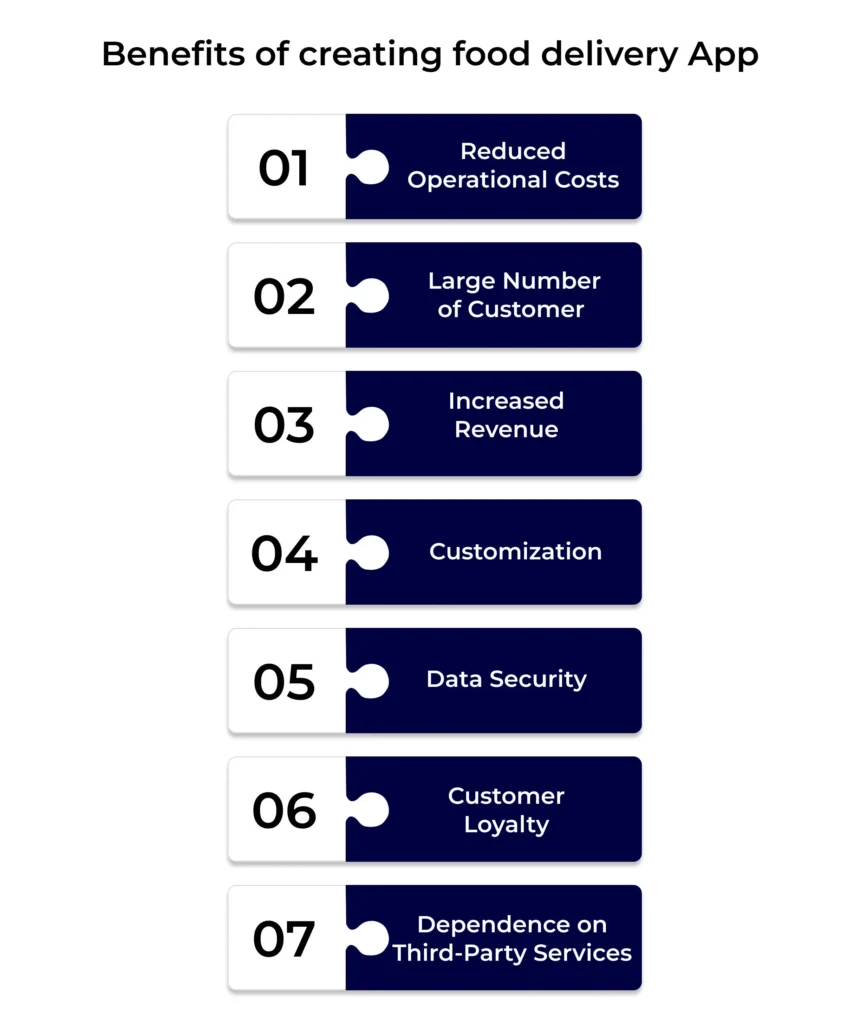
Reduced Operational Costs
It is the best solution to streamline your process by cutting operational costs. With food apps, you can avail yourself of some features to help you cut costs.
These apps offer real-time order tracking, multiple payment gateways, automated management for delivery persons, etc. All these functionalities can be performed with a single click, and you don’t need human assistance. It helps you to reduce operational costs and errors.
Cater to a Large Number of Customers
More than 2.85 million people globally use food delivery apps in 2023, according to TradingPlatforms. This shows that people find these apps more convenient and are inclined towards this trend. With food apps, businesses can reach and cater to many customers. Smaller or lesser-known eateries can gain visibility and reach a broader audience through these platforms.
Increased Revenue
It is the main reason that restaurants invest in food apps. Creating a food delivery app helps you generate revenue for your business. With these apps, more customers can place orders for takeout and delivery. This can lead to more sales and revenue.
Customization
You can customize your app according to your requirements. Add the features of your choice, such as order history, order cancellation, and more. The custom food delivery app improves the user experience and keeps customers back.
Data Security
All your personal and payment information is safe and secure compared to third-party platforms. Using your food-ordering app, you can implement security measures to protect customer data and secure payment processing.
Improve Customer Loyalty
Restaurants can improve customer loyalty by providing deals, discounts, and special offers to customers on their food app. It helps to build trust and customers more use your app for ordering food online. Also, it is one of the most cost-effective ways a brand can increase ROI.
Reduce Reliance on Third-Party Delivery Services
Creating your own food delivery app can reduce the use of third-party delivery services to provide services to customers. Using your app, you can provide better services to customers with your own rules rather than using any other delivery services.
Revenue Streams for Food Delivery Apps
The revenue stream is the most important factor before starting an online food delivery business. You must establish effective revenue streams to run a successful food delivery business.
Below are four different revenue streams to generate revenue for your business.
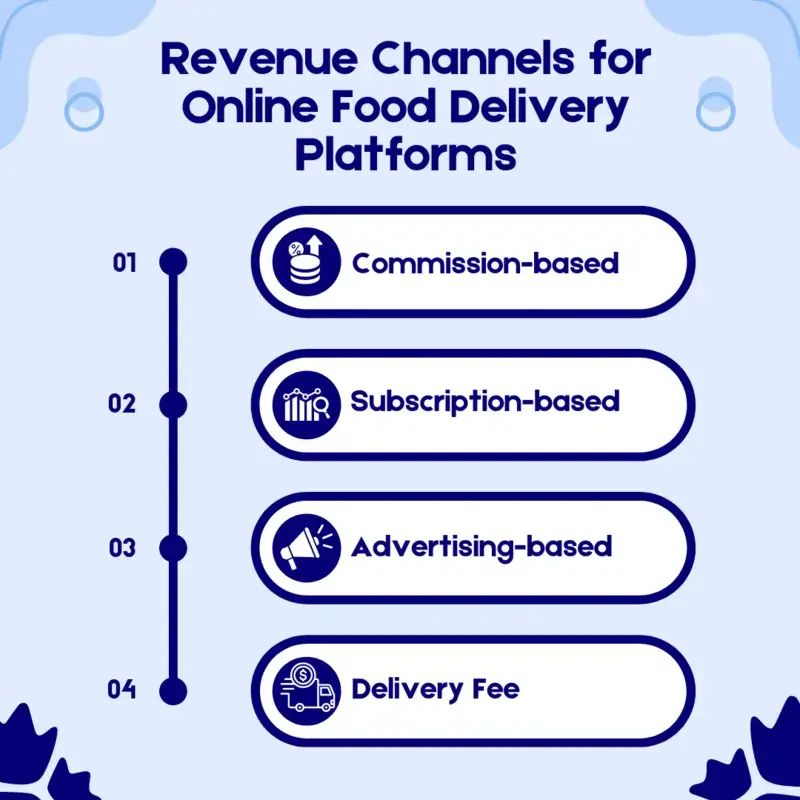
1. Commission-based
On each order placed via the platform, the admin sets a specified commission. The customer pays, and the admin receives it. After deducting the commission, the admin credits the amount to the restaurant’s wallet.
| Pros | Cons |
| Scalability | High fees for restaurants |
| Low upfront cost | Revenue is directly tied to the number of orders |
| Flexible pricing tiers |
2. Subscription-based
For merchants to register their restaurants on the network, the administrator may set up several subscription packages (individual and corporate). A merchant can select the subscription package that best suits their needs when they register for an account on the food delivery platform.
The merchant can subscribe to the corporate package if he wants to register numerous restaurants on the portal, but they can choose the individual package if they only want to register one. Merchants would pay the admin pre-decided fees to subscribe to these packages.
| Pros | Cons |
| Predictable revenue | Limited revenue per order |
| Lower customer fees | Difficult to set the right price |
3. Advertising-based
Another way to generate revenue from the food ordering and delivery app is to run third-party advertisements. The admin can charge from the third party for displaying their ads on the platform.
| Pros | Cons |
| Increase restaurant visibility | Restaurant competition may increase |
| Flexible monetization | Require a large user base |
4. Delivery Fee
The admin can generate revenue by charging the delivery fee from the customers. Also, the admin sets the delivery fee amount, and they have the authority to impose additional fees to generate revenue from it.
| Pros | Cons |
| No bad impact on the restaurant | Varying costs in different areas |
| Predictable revenue | Varying fee structure |
| Customizable pricing |
Supercharge your deliveries with Enatega.
Schedule a Call NowKey Features of a Successful Food Delivery App
What makes a good food delivery app?
Before creating the food delivery app, it is crucial to know that it is not just an ordering system. However, it offers various features that make it worth using.
Here are the main features of a successful delivery food app.
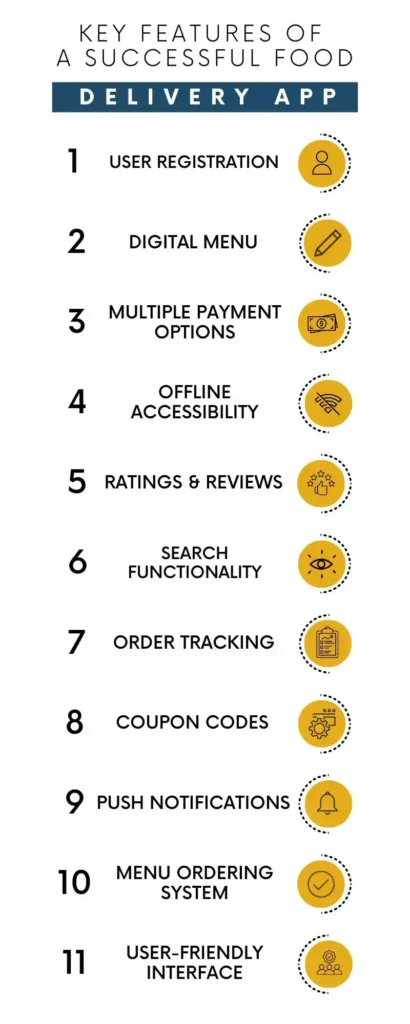
User Registration
Food delivery apps have different types of users, each with a profile. The main users of delivery food apps are:
Customer: The customer will browse food menus and add them to the cart.
Restaurant: The restaurants allow updating menu items, pricing information, and managing orders.
Delivery Driver: If your service employs third-party drivers, you require a distinct driver interface. This lets them take orders and receive pick-up instructions. To deliver products fast, drivers need turn-by-turn GPS directions with map integration.
Admin Panel: The product owners can manage the complete platform using the admin panel.
Digital Menu
With a digital menu, the customers can view all your menu items with high-quality images and descriptions of dishes. You can easily customize and update menu templates to add prices, dietary information, colors, portion sizes, and more that suit your needs.
Multiple Payment Options
A good delivery food app offers various payment options. Customers can easily pay through credit cards, debit cards, cash on delivery, and digital wallets. When giving more payment options to customers, they use the service more.
Offline Accessibility
Offline accessibility enhances user experience. This feature allows users to access the menus and basic information in areas with a weak or no internet connection. The users can engage more with your app and plan their orders without an internet connection.
If customers can access restaurant information offline, like the phone number, location, and menu, it can reduce customer service workload because consumers can find answers to their questions.
Ratings and Reviews
You can improve customer experience and stand out from nearby restaurants with ratings and reviews. They can also help other customers make an informed decision before ordering.
Search Functionality
The food app builder provides a quick way to order food without scanning the entire menu. It is difficult for customers to scroll through hundreds of items and place an order. The best way is to categorize them so the customer can easily order.
For restaurants, the categories include:
- Breakfast
- Lunch
- Dinner
- Dessert
- Salads
- Starters
- Pizza
Order Tracking
Order tracking helps restaurants manage orders online through the app or website. Users can also easily monitor the progress of their orders. Also, the app provides the live location of the delivery driver and the estimated delivery time.
Coupon Codes
Food delivery services, like any business, thrive on customer loyalty. Coupon codes are the best way to attract and retain customers. The restaurants generate coupon codes and provide them to customers as an incentive. The coupon codes help customers get discounts and save money on their next orders.
Push Notifications
Push notifications can help customers know about upcoming deals and promotions. With this feature, the restaurants can include these types of messages, such as:
- Are you craving pizza?
- Are you looking for a new restaurant in your area?
- Get FREE delivery!
- Buy one donut and get one free.
- Get 50% off on your next order.
All these notifications would motivate users to open the delivery food app. Plus, these notifications can remind customers when a driver has arrived with their order.
A great example of push notifications is you can send promotions around lunchtime when customers in their home or office want to order something.
Menu Ordering System
The menu management system is a crucial feature that allows restaurants to manage their menu or product listings. Adding an eye-catching menu to your food-ordering app gives you the chance to attract more customers and increase visibility.
User-Friendly Interface
A user-friendly interface of the food app can enhance your customer experience. Always equip your app with top-notch features like advanced search filters, order tracking, order history, and live chat that help you gain more customers.
How Much Does It Cost to Make a Food Delivery App?
Providing the exact cost of developing an app without specific project details is challenging. The cost of developing the delivery food app depends on various factors, such as:
- App features and complexity
- App design
- Technology
- Maintenance and updates
- Number of platforms
- Third-party integrations and more
The below table shows the rough estimate for building the food app.
| Factor | Cost Range |
| App Features & Complexity | $30,000 – $100,000+ |
| App Design | $5,000 – $20,000 |
| Technology Used | $10,000 – $30,000 |
| Maintenance & Updates | $5,000 – $15,000 per year |
| Number of Platforms (iOS, Android) | $20,000 – $50,000 per platform |
| Third-Party Integrations | $5,000 – $20,000 |
Challenges Faced When Create Your Own Food Ordering App
Here are some challenges that food delivery businesses may face when creating a delivery app.
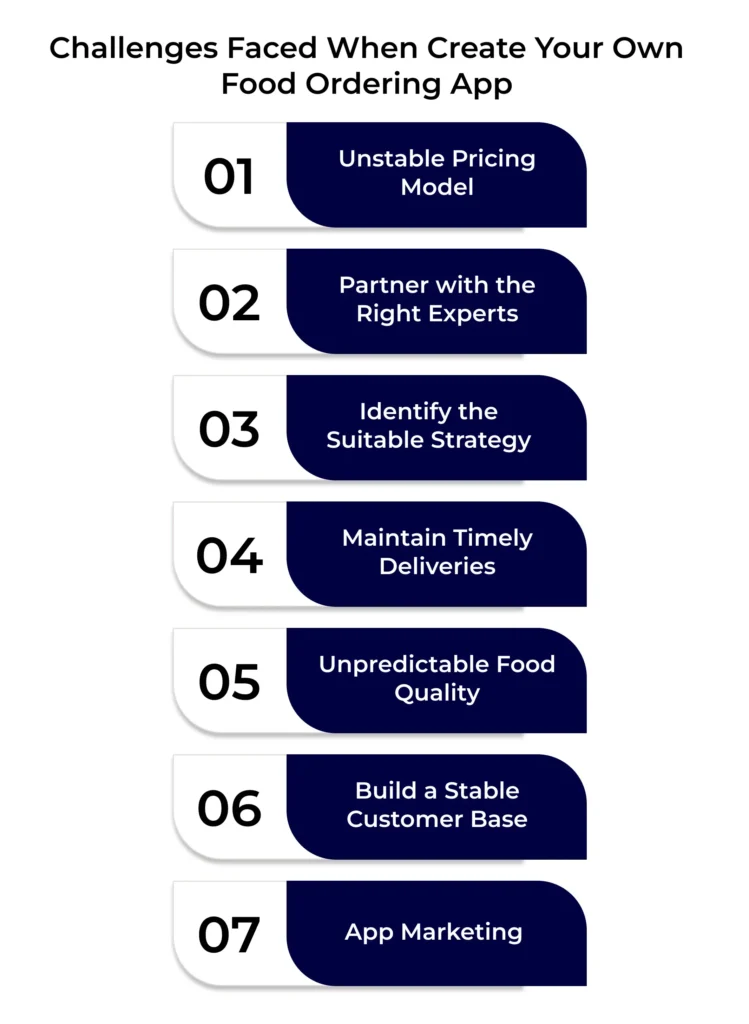
Unstable Pricing Model
Several new players are joining the food delivery industry. Therefore, it is difficult for businesses to determine the right pricing strategy. The startups prefer to work with low margins and grab the user’s attention. They use different pricing models to stay competitive.
To solve this problem by thoroughly analyzing the pricing policy of the established businesses and get an idea of prices. With this, you can develop a good pricing strategy.
Partner with the Right Experts
When you create your own food delivery app, partnering with the right food delivery experts requires a lot of effort. However, partnering with established ones will help you establish a brand image. There are many food outlets, so filtering the best can be challenging.
To simplify this challenge, working with an onboarding expert is best. They provide support to the restaurants that make the process easy.
Identify the Suitable Strategy
Finding new users can be challenging if you have full-fledged food delivery software. You need to use the most suitable marketing platforms. Fast-changing customer preferences might make marketing strategy creation difficult.
The best way is to create an advertising plan and list all your marketing strategies. Plus, it is good to communicate with food bloggers to build a strong online presence and improve brand visibility.
Maintain Timely Deliveries
Businesses may need help to deliver orders on schedule, especially at peak hours or in busy areas. Companies may optimize delivery routes, use real-time traffic data, or work with third-party logistics providers to overcome this.
Businesses may reduce delays, boost customer happiness, and stay competitive by optimizing delivery procedures. Technology like route planning software and tracking systems can improve visibility and help them anticipate delivery bottlenecks.
Unpredictable Food Quality
Many restaurants struggle to maintain food quality and freshness throughout delivery. Road bumps, motions, and vibrations stress food during transport. All of this can reduce food freshness.
Entrepreneurs should evaluate restaurant partners’ packaging and safety policies before adding them to their food delivery platform. To maintain freshness, restaurants should utilize high-quality packaging like insulated food bags.
Build a Stable Customer Base
In the eCommerce age, food delivery systems are growing. So, clients are overloaded by choices. Engaging new users and keeping them on your platform takes time and effort.
A restaurant or delivery business with greater rates, incentives, and advantages gets the most customers. However, consumer engagement and retention are not guaranteed.
Running a referral program and offering new clients discounts and incentives is the best solution to this problem. You can also design a smart app with an easy-to-use UI.
App Marketing
It is a real challenge that businesses face when they start marketing their food delivery app. With numerous apps available, it can be difficult to stand out and grab the attention of the target audience.
To overcome this challenge, you need to pay attention to things that differentiate your brand.
- Identify unique features
- Use social media
- Use influencer marketing
- Offer discounts
Our Successful Story
Case Study: Snap Delivered – A Food Delivery Platform
Challenges
Snap Delivered, a food delivery platform similar to Foodpanda and UberEats, faced several key challenges:
Rider Management: Effectively managing their network of delivery riders was a critical operational hurdle.
Expanding Reach: Growing their service area and customer base was essential for increasing market share.
Gaining Traction: Establishing a significant position in the competitive food delivery industry was a top priority.
Maintaining Budget: Carefully managing their financial resources was necessary for sustainable growth.
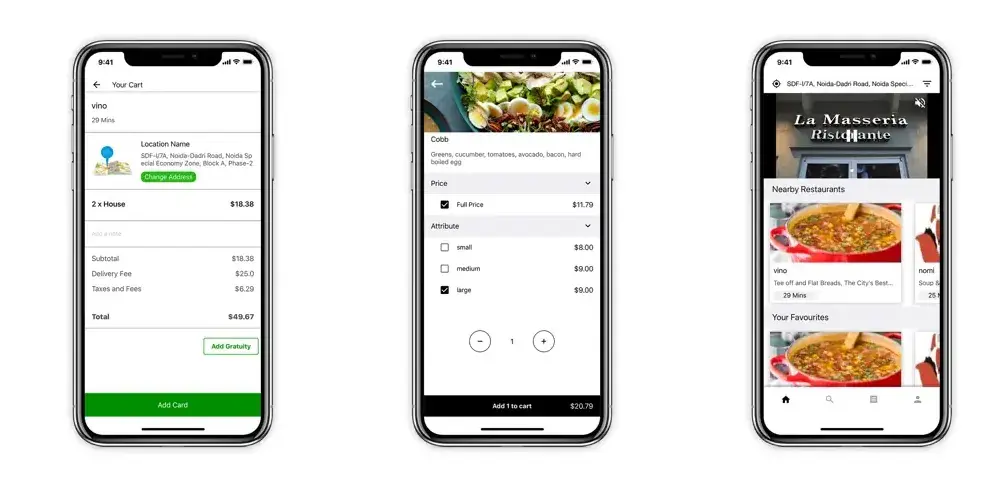
Solution
To address these challenges, Snap Delivered partnered with Enatega, a leading open-source solution provider. Enatega’s comprehensive support enabled Snap Delivered to:
Optimize Rider Operations: Enatega’s advanced rider management system helped Snap Delivered efficiently coordinate their delivery fleet, improving response times and customer satisfaction.
Improve Geographical Expansion: Our scalable platform allowed Snap Delivered to rapidly expand its service area, reaching new customer segments.
Gain Competitive Edge: Enatega’s innovative features helped them enhance their customer experience, driving increased user acquisition and retention.
Achieve Financial Sustainability: Enatega’s cost-effective solutions enabled Snap Delivered to maintain a healthy budget, paving the way for long-term growth.
Result
Through the strategic partnership with Enatega, Snap Delivered was able to overcome its key challenges and achieve remarkable success.
What Our Clients Say
Supercharge your deliveries with Enatega.
Schedule a Call NowFAQs
1. How do I create an app for my food business?
Below are some steps to help you build your own food delivery app for your food business.
- Research
- Choose the business model
- Select the key features
- Start working on the design of the app
- Start development
- Testing
2. Why are food apps so popular?
The food apps are popular because they are a convenient way for customers to place orders anywhere and anytime from several restaurants.
3. How to build a food delivery app like Uber Eats?
Building an app like UberEats is relatively easy if you know its business model, key features, and functionalities. To create the app, you must conduct research and have strong programming skills.
4. How long does it take to build an app like DoorDash?
The time to develop an app like DoorDash takes 4 to 6 months. However, it depends on your requirements like what features you add, what platform you use, what tech stack you use, etc.
5. Can I create an app like DoorDash?
You can create an app like DoorDash by following these simple steps.
- Create the business plan
- Do research
- Decide the model
- Select the features
- Start the app development
- Testing
6. How do I make a food delivery app without coding?
You can create your own food delivery app without coding by using the app builder or get help from the development company to build the app.
7. How much does it cost to build an app like DoorDash?
Building an app like DoorDash costs between $12,000 and $16,000. However, it varies and depends on your app requirements.
8. What delivery app makes the most money?
Below are some delivery apps that make the most money.
- Saucey
- DoorDash
- Instacart
- Postmates
9. How to make a delivery app without coding?
Below are some steps to help you make a delivery app without coding.
- Choose the app template.
- Customize the app template according to your requirements.
- Customize the data.
- Add new elements, screens, and features.
- View the app from different device screens.
- Publish the app to the App stores.
Conclusion
Food delivery apps are profitable and are great for local restaurants to expand their business. With delivery food apps, you can connect with many customers. Therefore, investing in and creating your own food delivery app is crucial to stay competitive.
You already know the steps required to create the food app. However, if you don’t have time or need expert help, consult Enatega. We have experts who use the latest technologies and deliver the best product for your business.
You can start your own food delivery business by downloading our app from iOS and Google Play stores and customizing it according to your needs.
So, now your "how to create a food delivery app" problem is solved. Book a demo with us and get the best app for your business.












 IOS
IOS Android
Android